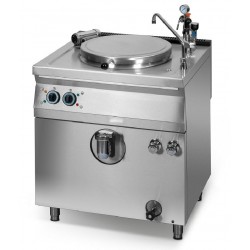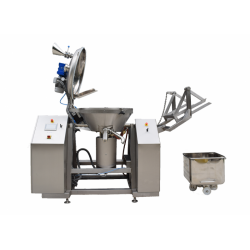Meat processing
Meat processing on an industrial scale includes a wide range of methods, including slaughter, butchering, curing, smoking, and packaging. Each of these steps requires special equipment to ensure the safety and quality of the final product.
Animal slaughter equipment typically includes stunning devices, animal restraint equipment, and killing tools. Once the animal has been killed, it is taken to a butchering area where it is skinned, entrails removed, and separated into various cuts of meat using various cutting and trimming machines.
Salting is another important process in meat processing that involves the addition of salt, sugar, and other ingredients to enhance flavor, texture, and preservation. Salting equipment includes mixers, drum massagers and injection machines.
Smoking is also a common method used to add flavor and color to meat, or to preserve it. For this, smokehouses and smoke generators are used, and different flavors are used for different types of meat.
Finally, packaging equipment is used for sealing and storing meat products. This includes vacuum packaging machines, heat sealers and labeling equipment to ensure correct identification and traceability.
In general, commercial scale meat processing requires a variety of specialized equipment to ensure efficient and safe production of high quality meat products.
In catering establishments, in the kitchens of the Horeca sector, one of the most common methods is grilling, pan frying or oven frying. This method allows you to cook meat at different degrees of doneness, which allows you to control its juiciness and taste.
In addition, meat can be boiled, stewed or baked. These methods are often used for large cuts of meat such as beef or pork.
Convenience meat production is the process by which meat and other ingredients are made into ready-to-eat products. Typically, the production of semi-finished products is carried out at industrial enterprises using specialized equipment.
The production process includes several stages, from the selection of quality meat and its processing, to shaping, packaging and freezing of finished products.
In the first step, the meat is passed through specialized equipment to grind and mix with other ingredients such as spices, sauces, rice and vegetables. The mixture is then molded into the desired shape, such as patties, kebabs, chicken nuggets, etc.
The production of semi-finished meat products allows you to increase the shelf life of meat products, make them more convenient to use and expand the range of meat dishes.
Meat processing equipment in the food industry includes a wide range of devices and machines that are used to process raw meat into finished products.
For the primary processing of meat, machines for cutting, slicing and grinding meat are used, such as meat grinders, slicers, hole saws and crushers. Mixers, vacuum cleaners and molding machines are used to mix meat and other ingredients in the production of semi-finished products.
To process meat at high temperatures, frying, boiling, baking, and smoking machines such as smokers, ovens, cooking pots, and frying surfaces are used. For freezing finished products, special units for freezing and storing products are used.
An important element of meat processing equipment is equipment for cleaning, disinfection and waste disposal, such as meat washers, sterilizers, water treatment systems and waste processing equipment.
The list of equipment for processing meat and forming semi-finished meat products includes:
- Meat grinders
- Slicers
- Hole saws
- Сrushers
- Mixers
- Vacuumers
- Forming machines
- Smokehouses
- Furnaces
- Cooking kettles
- Frying surfaces
- Freezing plants
- Refrigerators
- Washers for meat
- Sterilizers
- Water treatment systems
- Waste processing equipment
This is not a complete list, and the specific set of equipment may vary depending on the type of products manufactured at the enterprise.

 English
English
 Deutsch
Deutsch
 Français
Français
 Español
Español
 Italiano
Italiano
 Português PT
Português PT











